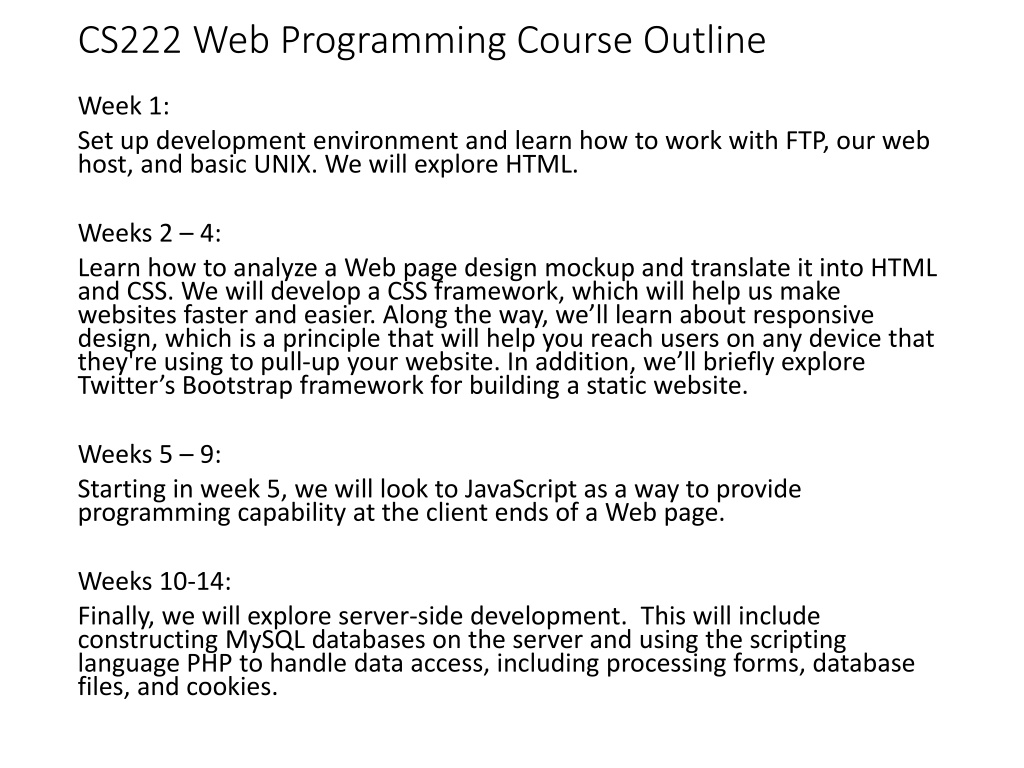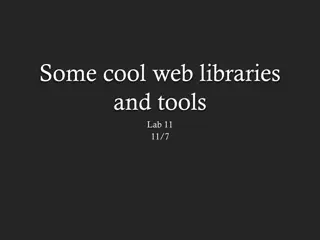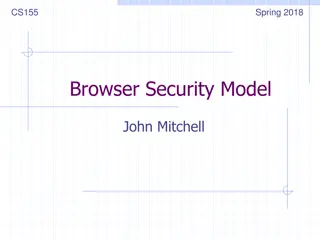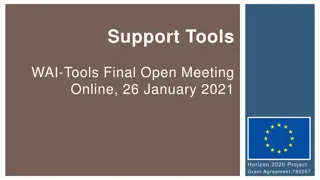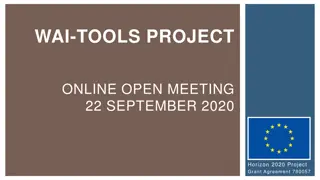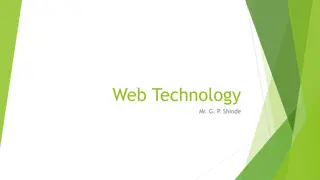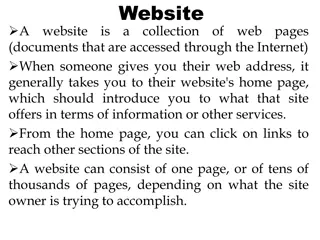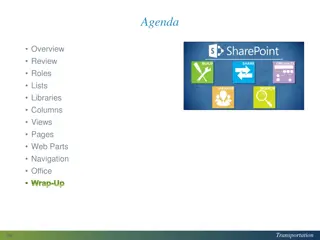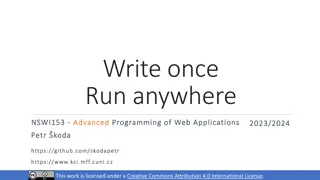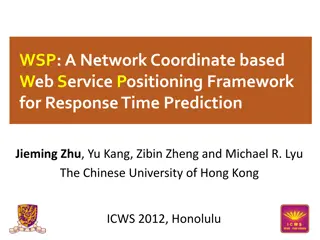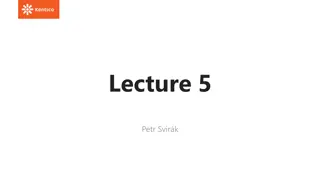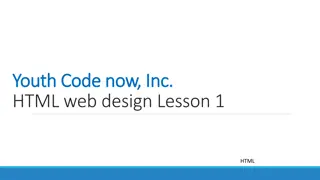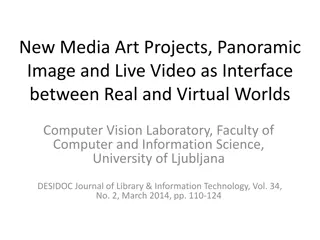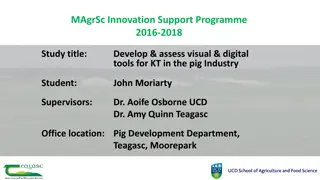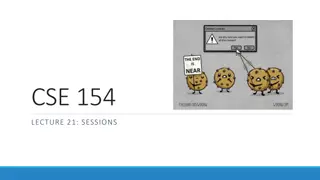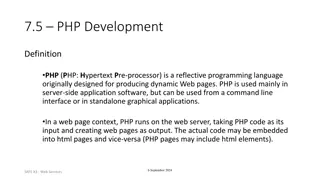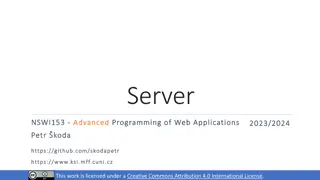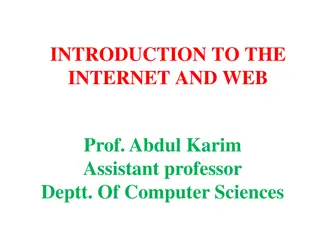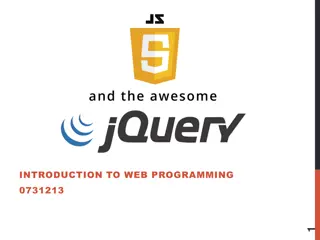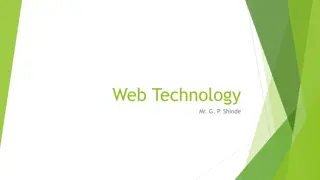Introduction to Web Development and Tools for Success
Explore the fundamentals of web programming with a focus on setting up the development environment, working with HTML, CSS, JavaScript, and server-side technologies. Learn how to analyze web page mockups, implement responsive design principles, and leverage tools like FTP, web hosting services, and Unix commands. Acquire essential development tools such as text editors, browsers, FTP software, and understand the components of a web application. Dive into networking concepts, TCP/IP, and the hardware components that make up the Internet.
Download Presentation

Please find below an Image/Link to download the presentation.
The content on the website is provided AS IS for your information and personal use only. It may not be sold, licensed, or shared on other websites without obtaining consent from the author. Download presentation by click this link. If you encounter any issues during the download, it is possible that the publisher has removed the file from their server.
E N D
Presentation Transcript
CS222 Web Programming Course Outline Week 1: Set up development environment and learn how to work with FTP, our web host, and basic UNIX. We will explore HTML. Weeks 2 4: Learn how to analyze a Web page design mockup and translate it into HTML and CSS. We will develop a CSS framework, which will help us make websites faster and easier. Along the way, we ll learn about responsive design, which is a principle that will help you reach users on any device that they're using to pull-up your website. In addition, we ll briefly explore Twitter s Bootstrap framework for building a static website. Weeks 5 9: Starting in week 5, we will look to JavaScript as a way to provide programming capability at the client ends of a Web page. Weeks 10-14: Finally, we will explore server-side development. This will include constructing MySQL databases on the server and using the scripting language PHP to handle data access, including processing forms, database files, and cookies.
Task for today: Acquire the Development Tools Text Editor: Atom, Sublime, Notepad++, or Aptana. Google Chrome. We will rely on Chrome s Developer Tools FTP Software, such as FileZilla or sFTP Client. We will also rely on Unix and FTP from the command line. Web Host: GoDaddy Do NOT use free hosting. These tools must be setup/activated before class on Thursday.
Topics for Today: What is a Web Application? Networks and the Internet What is Packet Switching? How does it differ from Circuit Switching? TCP/IP Telnet Experiment
Components of a Web Application Clients Web Server Network connecting clients to the web server
Definition of web application components The clients are the computers and devices that access the web application. A client device can be anything that can access a network. There is tremendous diversity in the client of devices. A web server holds the files that make up a web application. For example, TrishCornez.com is where students can go to access class assignments and labs for courses they are taking from me. The name trishcornez.com is the address of the webpage, or more commonly known as the URL. This address points to files located on a server that is running 24/7. A network connects the clients to the web server. Access to the network is often gained through a web browser, such as Chrome.
Networks and the Internet The Internet is a network that consists of many networks. Network Hardware Components: Modem Router The router is wired to the modem and the modem is connected to an Internet Service Provider (ISP) by fiber, DSL, or coaxial cable.
Modem A modem is designed to encode and decode data so that it can pass to and from the Internet. It facilitates a connection to the Internet by transmitting and receiving data over telephone lines.
Router A router shares your Internet connection among multiple devices. The router is connected to the Internet through the modem. The router uses a single public IP address on the Internet. Servers on the Internet can communicate with your router, and the router routes that traffic to the appropriate devices on your network. There is an Ethernet port on the back of the router that allows us to directly connect to the router for faster Internet access. The router is wired to the modem and the modem is connected to an Internet Service Provider (ISP) by fiber, DSL, or coaxial cable.
Major Hardware Components Basic Connection to the Internet Modem: Designed to encode and decode data so that it can pass to and from the Internet. Router: Shares an Internet connection among multiple devices.
Internet Network The Internet is a network of networks It has structure, but there is no centralized element. There is no centralized authority Different types of networks can communicate with each other.
The Internet architecture The Internet architecture An Internet service provider (ISP) owns a network that is connected to the Internet. At the top of the Internet hierarchy sits the global ISPs who provide service to regional ISPs, mobile networks, corporations, government, and academic institutions. The regional ISPs provide Internet service to end users, small business, mobile, and institutions. Together the global ISPs, regional ISPs, maintain the links to the Internet, which are usually constructed with a mesh topology (any to any connections). A DNS Server (Domain Name System) contains a database of network addresses to other networks. It translates a domain name and host name into the corresponding numeric address. The numeric address is the Internet Protocol address, or IP address. We will do an experiment shortly to better understand this.
Internet Architecture An Internet Service Provider (ISP) owns a network that is connected to the Internet. Global ISPs provide service to regional ISPs, mobile networks, corporations, governments, and academic institutions. Regional ISPs provide Internet service to end users, small businesses, academic institutions, etc. DNS Server (Domain Name System) contains a database of network addresses to other networks.
How Data Travels Across the Internet Packet Switching
Packet Switching was a Revolutionary Concept Data is broken up into small packets. Multiple people can use the same wire. Packet Switching Circuit Switching
Packet Switching and TCP/IP Example TCP - Transmission Control Protocol IP - Internet Protocol Imagine an Android user wants to view a web page that is hosted on a Web Server. Packet Switching How is this webpage sent to the device from the Web Server?
Packet Switching and TCP/IP Example Step 1: Using TCP protocol the webpage is broken up into multiple small fixed size packets. Each packet contains a final destination.
Packet Switching and TCP/IP Example Step 2: Multiple routers live within the core of the Internet itself. A router determines where to send each packet. Packets travel from router to router according to the IP protocol.
Packet Switching and TCP/IP Example Step 3: Each packet is routed according to the best Internet traffic report. All packets for this request have the same final destination, the IP address.
Packet Switching and TCP/IP Example Step 4: TCP is run again when the packets arrive at their final destination. TCP reassembles the small packets into the original whole webpage.
Difference between URL and IP In order to find what you want on the internet, you need to have a pointer of where to find it. URLs (Uniform Resource Locators) and IP addresses are identifiers used for this purpose. The main difference between URL and IP address is what they point to. An IP address basically points to a computer, whether it is the physical hardware or a virtual one as in the case of shared hosting. A typical URL contains the protocol to be used (i.e. HTTP, FTP), the domain name or IP address, the path, and optional fragment identifier. It is obvious to see that an IP address can be part of a URL, although it is more common to see a domain name instead of an IP address.
IP Experiment The IP address of a packet is used to determine direction and a final destination. The IP address is a unique 32-bit number, written as four 8-bit numbers separated by periods. Users typically use domain names, but IP numbers work just as well. Task 1: Use telnet in terminal mode to connect with University of Redlands. This will reveal its IP address. Task 2: Load Chrome and connect to University of Redlands using the IP address. TIP: type the string http:// followed by the IP number and then a forward slash.
